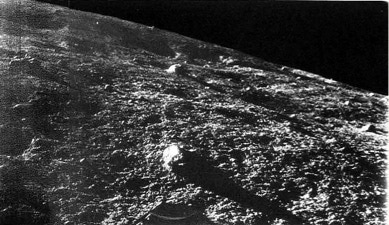

Exploring the Moon
A history of lunar discovery from the first
space probes to recent times
Landers and orbiters – 1
After these early excursions, the race was on to obtain the first views from the lunar surface itself. Another Soviet probe, Luna 9, achieved this in February 1966 when it descended onto the western Oceanus Procellarum, the largest of the Moon’s dark lowlands. Over the next three days Luna 9 took panoramas of its surroundings, showing a scattering of rocks and the rim of a nearby crater. Luna 9’s signals were monitored by the giant radio telescope at Jodrell Bank, which released the first picture before the Russians. Unfortunately, the horizontal scale was too compressed and gave the surface an unrealistically jagged appearance.
Luna 9’s landing system was only rudimentary – the craft was a reinforced sphere ejected from the carrier probe shortly before impact, and it dropped onto the surface at car-crash speed. A more advanced system, using braking rockets that provided a genuine soft-landing similar to that intended for manned landings, was employed by the US Surveyor series, the first of which touched down four months after Luna 9, also in Oceanus Procellarum. Surveyor 1’s successful landing finally dispelled fears that the surface was covered in deep drifts of dust that might swallow a crew of astronauts.
Even so, the surface was not bare rock, but a compacted soil known as the regolith, built up over aeons by meteorite impacts. The regolith covering the maria is now known to be about 5 m deep, thickening to two or three times that in the highlands.
Out of seven attempted Surveyor landings five were successful, and confirmed that the Moon was perfectly safe for humans to land and walk on. Each Surveyor carried a TV camera to photograph its surroundings. Three of them carried a soil analyser which found the composition of the maria to be similar to that of volcanic basalt on Earth, and two of them were equipped with a mechanical arm to dig in the soil. One of them, Surveyor 3 (pictured), was subsequently visited by astronauts during the Apollo 12 mission.
Several of the Surveyors have since been photographed on the surface by NASA’s Lunar Reconnaissance Orbiter probe.
Landers and orbiters 1
The far side of the Moon, from Luna 3
Surveyor 3 on the Moon

